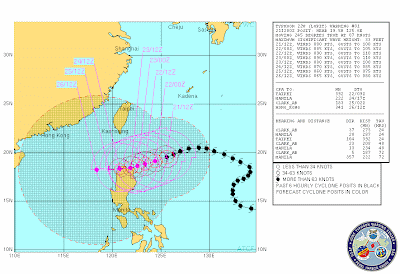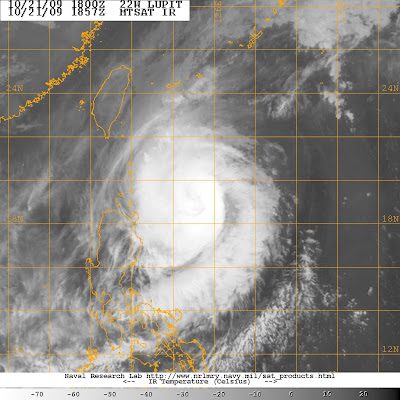 However, the storm is now moving slowly and is likely to continue to do so, which makes forecasting its track much more difficult. The major concern is that the JTWC forecast above suggests that the storm will track across Luzon very slowly, which is very bad news in terms of landslide and flood generation. However, some forecast models (such as the GFS model) suggest that the slow movement may allow the regional air pattern to change, which could cause the storm to recurve and head to the north, which would spare Luzon. This remains quite unlikely, but would be very fortunate indeed. On the other hand, some other forecasts suggest a more southerly track than the JTWC one.
However, the storm is now moving slowly and is likely to continue to do so, which makes forecasting its track much more difficult. The major concern is that the JTWC forecast above suggests that the storm will track across Luzon very slowly, which is very bad news in terms of landslide and flood generation. However, some forecast models (such as the GFS model) suggest that the slow movement may allow the regional air pattern to change, which could cause the storm to recurve and head to the north, which would spare Luzon. This remains quite unlikely, but would be very fortunate indeed. On the other hand, some other forecasts suggest a more southerly track than the JTWC one.The storm itself is now quite weak (only a category 2), but may well strengthen a little over the next few hours. This suggests that if the storm does come ashore the major issue will be the rainfall rather than the winds / storm surge. The eTRaP data, which forecasts rainfall for the next 24 hours, indicates the intensity of the rainfall associated with this storm (NB the scale is in inches, 1 inch = 25.4 mm):
 The satellite imagery suggests that the outer edge of the storm (i.e. the high level cloud) has just about reached the Luzon coast, although the main part of the storm is still quite some distance away:
The satellite imagery suggests that the outer edge of the storm (i.e. the high level cloud) has just about reached the Luzon coast, although the main part of the storm is still quite some distance away:
If the storm does come ashore then an interesting site to keep an eye on might be that of a professional extreme weather photographer, John Edds, who is out there and is blogging on the preparations that the local people are taking. You can view his report here.
No comments:
Post a Comment